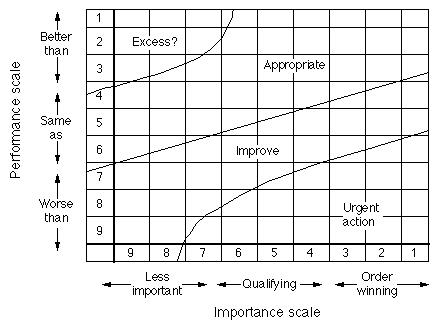Importance / Performance Matrix

A crucial stage in the formulation of operations strategy is the derivation of a ranked (or rated) list of competitive factors such as quality, flexibility, cost, etc. This list is used either to infer an appropriate set of strategic operations decisions or, in conjunction with an independently derived list of the organisation's performance to prioritise each of the competitive factors.
A 2x2 matrix of importance / performance can be used but may be found too crude. The matrix shown here uses the 9-point importance and performance scales reproduced below.
The exact positions of the dividing lines between the zones "Excess?", "Appropriate", "Improve" and "Urgent action" may need to be agreed by the group beforehand.
A Nine-point Importance Scale
For this product or service does each performance objective meet the following?
Order-winning objectives:
(1) provide a crucial advantage with customers - they are the main thrust of competitiveness;
(2) provide an important advantage with most customers - they are always considered by customers;
(3) provide a useful advantage with most customers - they are usually considered by customers;
Qualifying objectives:
(4) need to be at least up to good industry standard;
(5) need to be around the median industry standard;
(6) need to be within close range of the rest of the industry;
Less important objectives:
(7) do not usually come into customers' consideration, but could become more important in the future;
(8) very rarely come into customers' considerations;
(9) never come into consideration by customers and are never likely to do so.
A Nine-point Performance Scale
In this market sector, or for this product group, is our achieved performance in each of the performance objectives:
Better than competitors:
(1) consistently considerably better than our nearest competitor;
(2) consistently clearly better than our nearest competitor;
(3) marginally better than our nearest competitor;
The same as competitors:
(4) often marginally better than most competitors;
(5) about the same as most competitors;
(6) often within striking distance of the main competitors;
Worse than competitors:
(7) usually marginally worse than most competitors;
(8) usually worse than most competitors;
(9) consistently worse than most competitors?
References
- Nigel Slack, "The Importance-Performance Matrix as a Determinant of Improvement Priority", Int. J. of operations and production Management, Vol. 14, No. 5, pp 59-75, 1994.
Find us on









